Overview
Digital transformation in government presents a compelling opportunity to enhance operational efficiency, improve service delivery, and foster greater citizen engagement. Are government agencies meeting the evolving needs of their constituents? Evidence suggests that those embracing digital solutions have experienced up to a 40% increase in citizen satisfaction. Furthermore, substantial improvements in efficiency demonstrate the transformative power of technology in reshaping public administration. As a result, it is crucial for agencies to consider integrating digital solutions to better serve their communities and adapt to the changing landscape of governance.
Introduction
In an era where technology is fundamentally reshaping society, digital transformation in government emerges as a critical shift towards more efficient and responsive public service. This evolution represents not merely the adoption of new technologies but a thorough rethinking of how government agencies function and interact with citizens.
Consider the implications of process automation and enhanced data management; these initiatives are designed to promote greater transparency and citizen satisfaction. As governments worldwide prioritize these transformations, the integration of innovative solutions becomes essential, ensuring that legacy systems do not obstruct progress.
The journey toward a digitally empowered government is fraught with challenges; however, the potential benefits—such as increased operational efficiency and improved service delivery—compel agencies to embrace this vital change.
Understanding Digital Transformation in Government
The shift towards technology in public institutions exemplifies the remarkable benefits of digital transformation in government, significantly integrating electronic tools across all facets of public operations. This fundamental alteration of operational structures enhances the value provided to citizens. Initiatives such as process automation, improved service delivery, and enhanced data management are pivotal in demonstrating these benefits while fostering greater citizen engagement. The primary objective is to create an administration that is not only more effective but also transparent and responsive to the evolving needs of its citizens.
As we approach 2025, statistics reveal a growing emphasis on technological advancement within administrations, with over 70% of public sector entities reporting substantial improvements in operational efficiency. This reflects the transformative impact of digital integration in government. Avato’s hybrid integration platform is crucial in this context, ensuring 24/7 uptime for critical integrations and highlighting the importance of reliability in these initiatives. By simplifying complex integrations and maximizing the value of legacy systems, Avato empowers governments to streamline processes and enhance service delivery, with notable success stories emerging from various sectors.
The Digital Development Partnership has played an essential role in advancing technological evolution in low and middle-income nations, laying strong foundations that enable innovative applications for the online economy.
Avato, derived from the Hungarian term for ‘dedication,’ embodies a commitment to creating technology solutions that drive significant change. Experts emphasize the vital role of electronic technology in public administration. Numerous leaders advocate for a strategic approach to technological transformation, underscoring the necessity for comprehensive data collection strategies to better understand the effects of new technologies on labor outcomes.
A report from the Bureau of Labor Statistics highlights considerable gaps in knowledge regarding technology’s impact on the labor market, emphasizing the urgent need for improved methodologies in evaluating these influences.
The clear advantages of digital transformation in government are underscored by statistics indicating that agencies adopting electronic solutions have achieved up to a 40% increase in citizen satisfaction. Gustavo Estrada points to Avato’s ability to streamline complex projects and deliver results within specified timelines and budget constraints, showcasing the effectiveness of integration solutions in public sector environments. Furthermore, Avato’s platform offers real-time monitoring and alerts on system performance, enabling agencies to respond swiftly to emerging issues.
Case studies further illustrate successful technology integration in public administration, demonstrating how agencies have leveraged technology to enhance responsiveness and efficiency while significantly reducing costs.
In summary, the ongoing initiatives in technological advancement within public administration highlight the transformative benefits of digital transformation in government. These efforts are reshaping the governance landscape, enabling authorities to meet the needs of their constituents more effectively. As these initiatives continue to evolve, the focus remains on maximizing the potential of digital technologies to drive innovation and enhance service delivery across the board.
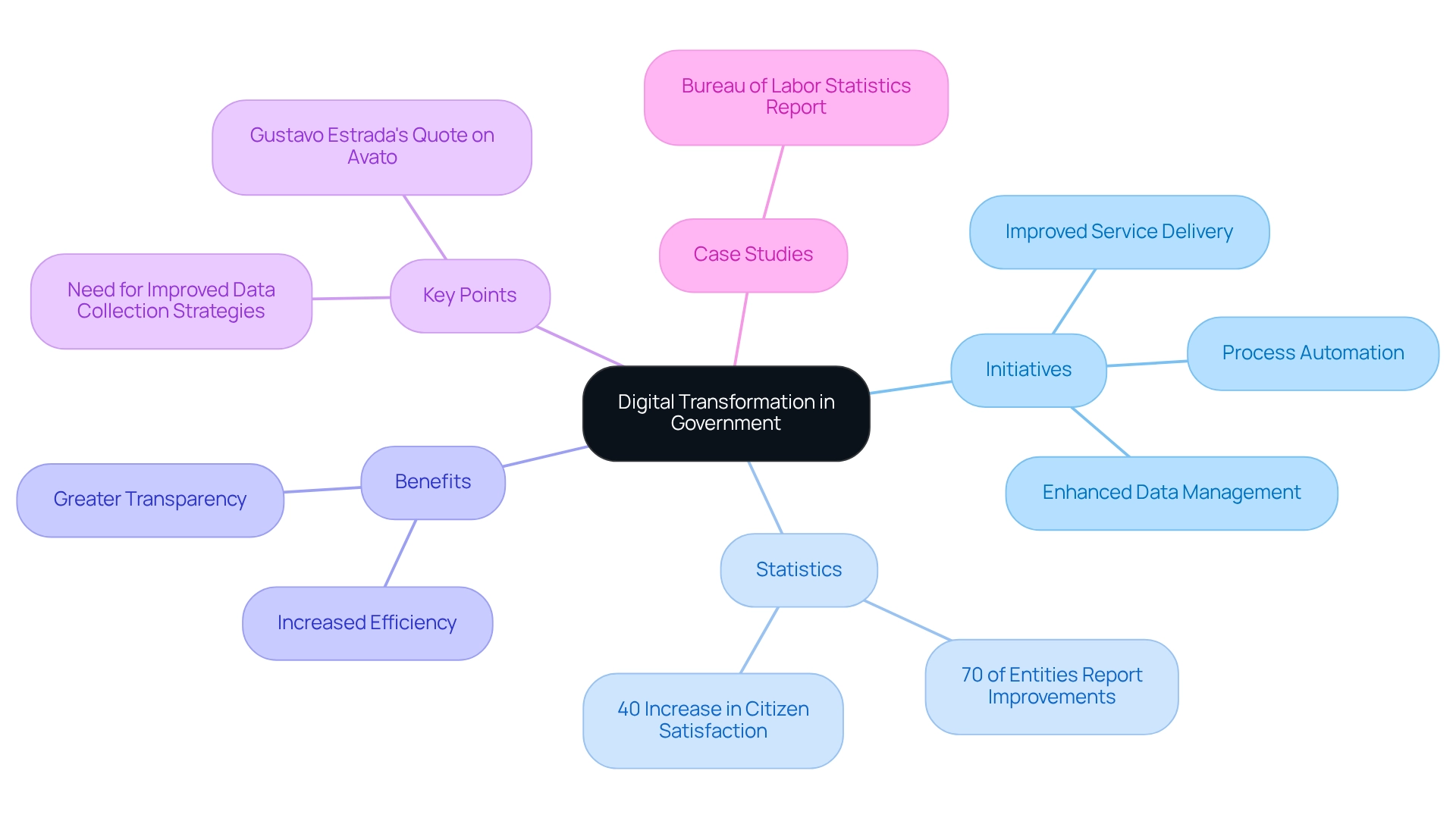
Key Benefits of Digital Transformation for Government Agencies
Digital change offers a multitude of benefits for digital transformation in government, fundamentally reshaping agency operations and citizen interactions. A primary advantage is the significant boost in operational efficiency. By automating routine tasks and streamlining processes, agencies can drastically reduce the time and resources needed to provide assistance.
Research indicates that organizations embracing technological change can achieve operational efficiency improvements of up to 30%, enabling more effective resource allocation. The global public cloud solutions market, projected to reach 596 billion USD from 2017 to 2025, underscores the scale of investment in technological transformation initiatives.
Furthermore, technological transformation is crucial for enhancing citizen engagement. By providing accessible and user-friendly solutions, government agencies empower citizens to connect through various electronic channels, such as mobile applications and online platforms. This transition not only enhances service delivery but also nurtures community involvement.
Metrics reveal that agencies experiencing technological change report a 40% increase in citizen satisfaction, as individuals can effortlessly track the status of their requests and access information at their convenience.
In addition to boosting engagement, technological change enhances data management and analytics capabilities. Governments can utilize real-time data for informed decision-making, leading to more effective policy-making and resource allocation. This capability is essential in today’s fast-paced environment, where timely information can significantly influence outcomes.
Avato’s Hybrid Integration Platform can facilitate this process by integrating legacy systems, ensuring seamless data flow across departments.
Moreover, the clarity and accountability fostered by technological transformation are paramount. Citizens can easily monitor their requests and access information, which builds trust in public operations. Consequently, agencies prioritizing online initiatives often see a marked improvement in public perception and trust.
However, it is crucial to recognize that only 35% of enterprises have met their technological change goals, highlighting the challenges public agencies may face.
In summary, the advantages of digital transformation in government lead to a more efficient and responsive administration, better equipped to serve its constituents. By addressing implementation challenges, such as skill gaps and resistance to change, agencies can enhance their prospects for successful technological change. Avato’s comprehensive five-step guide offers strategies for integrating legacy systems in finance, healthcare, and government, ultimately fostering improved long-term resilience and competitiveness in the market.
This guide features specific tools to help agencies effectively navigate their online change journey. Investing in technological change is essential for agencies to remain competitive and resilient in an evolving landscape, with workforce preparedness being crucial as employees are encouraged to enhance their skills for a technology-driven job market. For a visual overview of these steps, refer to our infographic outlining the key elements of Avato’s five-step guide.

The Role of Policy in Driving Digital Transformation
Effective policy is essential for driving technological change in government. It establishes a framework and guidelines necessary for implementing technological initiatives, ensuring alignment with overarching governmental objectives. Policies must not only promote innovation but also encourage interdepartmental collaboration and set rigorous standards for data security and privacy.
The OECD emphasizes the significance of a whole-of-government strategy. The benefits of digital transformation in government should be seen as a crucial element of public sector reform rather than an isolated endeavor. By nurturing a culture of creativity and enhancing technological skills among public employees, governments can promote an atmosphere favorable to successful transformation.
Consider the nations that have embraced comprehensive technological policies. They have observed considerable benefits from digital transformation in government, resulting in enhancements in operational efficiency and delivery. Notably, statistics indicate that only 6% of executives anticipate workforce reductions due to automation and AI. This suggests a shift towards enhancing capabilities rather than merely cutting jobs. This viewpoint aligns with the OECD’s suggestions for 2025, which stress the benefits of digital transformation in government through strong policy frameworks to promote technological innovation.
Furthermore, effective policy frameworks can lead to successful technological initiatives. Organizations that have implemented strategic policies have reported enhanced operational capabilities and reduced costs. For instance, Gustavo Estrada, a customer, praised Avato for its ability to simplify complex integration projects and deliver results within desired time frames and budget constraints.
Avato’s dedicated hybrid integration platform, powered by Red Hat technology, specifically tackles the challenges of integrating isolated legacy systems. This aligns with the discussion on operational efficiency and delivery enhancements. Avato provides an extensive array of offerings, including enterprise architecture, project management, and technical analysis, which are crucial for maneuvering through the intricacies of technological change. Furthermore, Avato’s worldwide collaborations with managed providers boost its capacity to offer customized solutions that fulfill varied client requirements.
Such examples demonstrate the crucial role of policy in influencing the future of public sector technological advancement. Avato offers a dependable, future-proof technology stack vital for adjusting to evolving requirements.
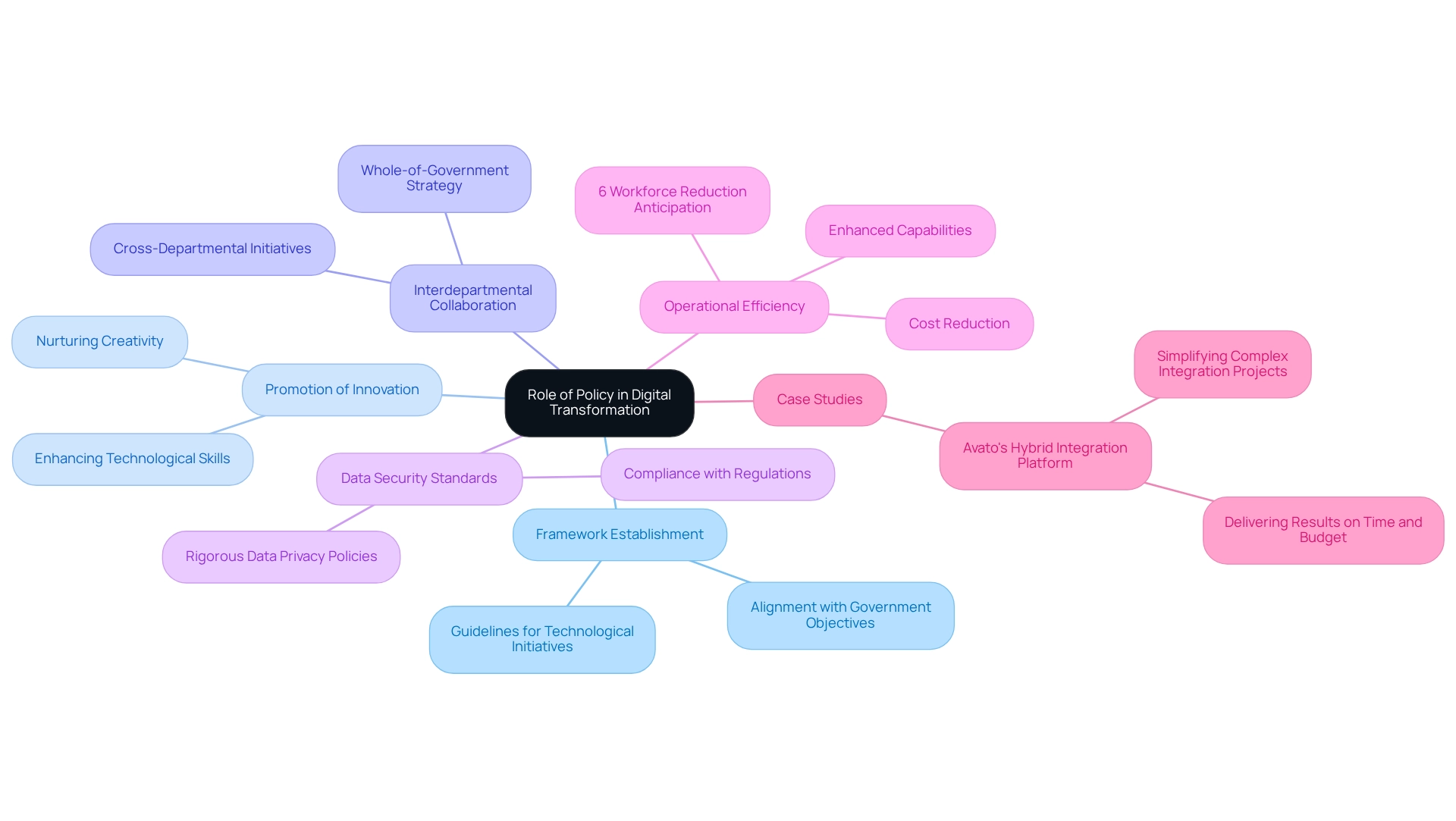
Global Perspectives on Digital Transformation in Government
The benefits of digital transformation in government are rapidly becoming a global trend, as nations worldwide embrace innovative technologies to enhance public service delivery. For instance, Estonia has emerged as a leader in e-governance, providing a comprehensive array of online services that enable citizens to interact with authorities seamlessly. This includes initiatives such as e-Residency, which empowers global entrepreneurs to establish and manage businesses online.
Similarly, Singapore’s Smart Nation initiative leverages technology to improve the quality of life for its citizens, focusing on areas like smart mobility and electronic healthcare.
By 2025, global data indicates that over 70% of governments will prioritize technological advancement, with significant investments earmarked for cloud infrastructure to support these initiatives. The adoption of cloud computing has become crucial, especially as organizations transition from on-premises solutions to scalable cloud environments, facilitating the implementation of advanced technologies such as generative AI. Avato’s dedicated hybrid integration platform is instrumental in this shift, ensuring 24/7 uptime for essential integrations and offering a dependable technology stack that aids businesses in adapting to evolving demands while streamlining disparate systems.
Successful e-governance examples, such as Ukraine’s Diia state applications and the eHealth initiative, illustrate how online platforms can enhance access to essential services. These initiatives not only boost efficiency but also highlight the advantages of digital transformation in government by fostering transparency and citizen engagement. As Tony Leblanc from the Provincial Health Services Authority remarked, “Avato accelerates the integration of isolated systems and fragmented data, delivering the connected foundation enterprises need to simplify, standardize, and modernize.”
This underscores the effectiveness of electronic advancement initiatives across various sectors, including banking and healthcare.
Leading practices in e-governance worldwide showcase the benefits of digital transformation in government by prioritizing user-focused design, robust cybersecurity measures, and continuous feedback systems to tailor services to citizens’ needs. Collaborative efforts, including international forums and knowledge-sharing platforms, are vital in facilitating the exchange of ideas and strategies. By learning from global examples and applying proven best practices, authorities can expedite their online evolution journeys, ultimately leading to improved service delivery and heightened citizen satisfaction, supported by Avato’s capabilities in enhancing operational visibility and problem resolution, including its backing for 12 levels of interface maturity and secure transactions.
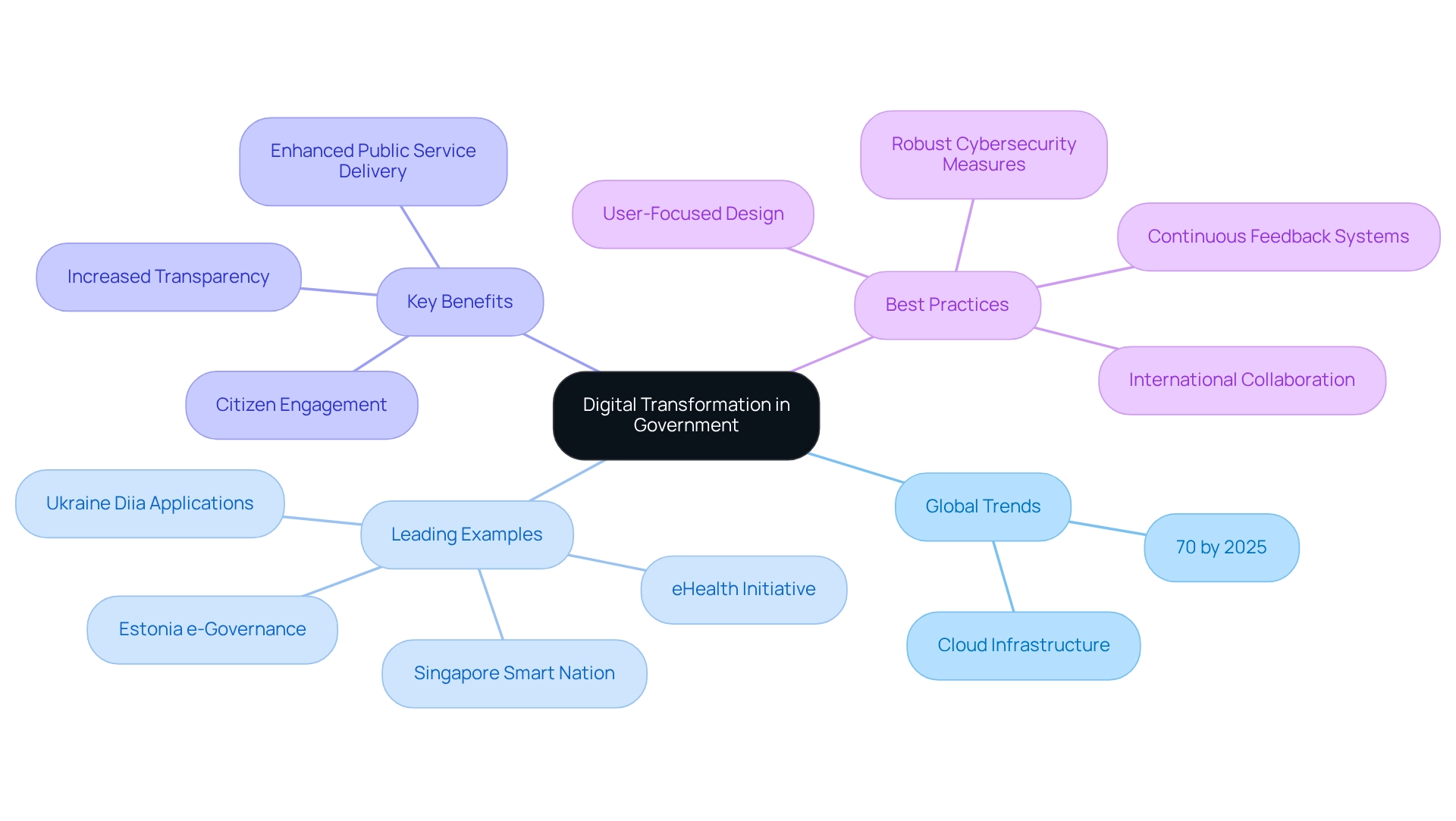
Challenges and Considerations in Government Digital Transformation
The digital shift in public administration offers substantial benefits through digital transformation in government, yet it also encounters significant challenges. A prominent obstacle is the prevalence of legacy systems, which frequently hinder the seamless integration of innovative technologies and processes. These outdated systems can create bottlenecks, complicating agencies’ efforts to modernize effectively.
As we approach 2025, authorities are increasingly focused on enhancing their technological capabilities, making the impact of these legacy systems on online initiatives a pressing concern.
Bureaucratic structures further complicate the transformation process. Resistance to change is prevalent, as employees may hesitate to adopt new methodologies and technologies. This reluctance can stall progress and undermine the potential benefits of technological initiatives.
Moreover, ensuring data security and compliance with stringent regulations is critical, particularly in sensitive sectors such as healthcare and finance, where the stakes are exceptionally high. For instance, all Statistics Canada employees must take an oath of confidentiality, which remains valid post-employment, underscoring the importance of data security in this context. To address these challenges, authorities must prioritize robust change management strategies.
This includes investing in comprehensive training programs to ensure staff are comfortable with new platforms while fostering a culture of adaptability and innovation. A phased approach to implementation can also prove beneficial, allowing for gradual adaptation to new systems and processes. For example, Statistics Canada is currently developing a data trust framework that emphasizes responsible data use while maintaining privacy and confidentiality.
This initiative seeks to enhance transparency and public confidence in data practices, showcasing a proactive strategy to tackle challenges in technological advancement.
Statistics indicate that over three-quarters (79%) of organizations are actively pursuing initiatives to bridge gaps in their technological capabilities amid a tightening IT labor market. IDC forecasts that global expenditure on technological change will approach $4 trillion by 2027, with a compound annual growth rate (CAGR) of 16.2% from 2022 to 2027. This highlights the necessity for authorities to respond decisively in their technological advancement initiatives. By addressing the challenges posed by legacy systems and promoting a supportive atmosphere for change, public sector organizations can unlock the benefits of digital transformation in government, ultimately leading to enhanced services and outcomes for citizens.
As Gustavo Estrada noted, Avato simplifies complex projects and delivers results within desired time frames and budget constraints, emphasizing the importance of effective integration solutions in overcoming legacy system challenges. Additionally, ensuring regulatory compliance and conducting security audits are crucial measures in safeguarding sensitive information and maintaining public confidence in initiatives.

Integrating Legacy Systems: A Key to Successful Transformation
Incorporating legacy systems is essential for achieving successful technological transformation within public sectors. Many organizations still rely on outdated systems that lack compatibility with modern technologies, complicating the implementation of new digital solutions. A strategic integration approach starts with a thorough assessment of existing systems to identify gaps and develop a comprehensive modernization plan.
This plan often involves adopting middleware solutions, which facilitate seamless communication between diverse systems, as well as utilizing APIs for effective data exchange. Statistics reveal that a significant percentage of public agencies face challenges due to legacy systems, with many asserting that these outdated technologies hinder their capacity to innovate. By effectively integrating legacy systems, authorities can enhance their operational capabilities, streamline processes, and improve service delivery while minimizing disruptions. Avato ensures round-the-clock availability for essential integrations, underscoring the reliability of these integration solutions.
Successful case studies demonstrate that agencies employing middleware solutions have achieved higher success rates in their online advancement efforts. For example, organizations that have embraced middleware report improved interoperability and reduced integration times, enabling them to phase out obsolete systems gradually. Companies relying on legacy systems have three primary options:
- Preserve the existing system if it meets current needs
- Modernize it by transitioning to the cloud or adding features
- Replace it entirely with a new system
Expert opinions highlight the significance of these solutions, emphasizing that they not only simplify the integration process but also provide a dependable framework for future upgrades. Gustavo Estrada, a client, praised Avato for its ability to streamline complex projects and deliver results within preferred time frames and budget constraints.
Ultimately, a well-organized approach to integrating legacy systems is crucial for public agencies aiming to modernize their technology infrastructure. By leveraging Avato’s hybrid integration platform, dedicated to simplifying disparate systems and enhancing business value, these agencies can position themselves to meet current demands and improve their overall operational efficiency. The strategic importance of XML technologies for data interoperability and longevity further enhances Avato’s solutions, ensuring that agencies can navigate their transformation journeys with speed, security, and simplicity.

Ensuring Security and Compliance in Digital Government Initiatives
Safety and adherence are paramount in electronic administration efforts, particularly due to the sensitive nature of information managed by public sector entities. With ransomware incidents escalating—evidenced by a staggering 67% increase in the energy sector from 2022 to 2023—the urgency for robust cybersecurity measures is unmistakable. Ransomware has emerged as the foremost cybercrime threat to Canada’s critical infrastructure, necessitating that governments adopt a zero-trust security model, conduct regular security assessments, and ensure compliance with relevant regulations and standards.
A critical analysis reveals the risks associated with vendor concentration in technology, where reliance on a limited number of large providers heightens cyber vulnerability. Disruptions affecting these dominant vendors can result in widespread data breaches, impacting numerous organizations reliant on their services. This scenario underscores the necessity for public sector organizations to diversify their technology partnerships and implement comprehensive cybersecurity strategies.
Moreover, cultivating a culture of security awareness among employees is vital to mitigate risks stemming from human error. As Eric Raymond aptly stated, “Being able to break security doesn’t make you a hacker any more than being able to hotwire cars makes you an automotive engineer.” This perspective highlights the importance of a deeper understanding of cybersecurity that transcends mere technical skills.
By prioritizing safety and adherence, authorities can not only protect sensitive information but also foster public confidence in the advantages of digital transformation within government, a key factor for the long-term success of technological advancement initiatives. As we approach 2025, the focus on cybersecurity in online government initiatives will be critical, with organizations needing to adeptly navigate compliance challenges while implementing effective strategies to safeguard their electronic assets. Furthermore, students are encouraged to integrate cybersecurity content into their architecture models, underscoring the significance of education and awareness in nurturing a culture of security within public sector organizations.
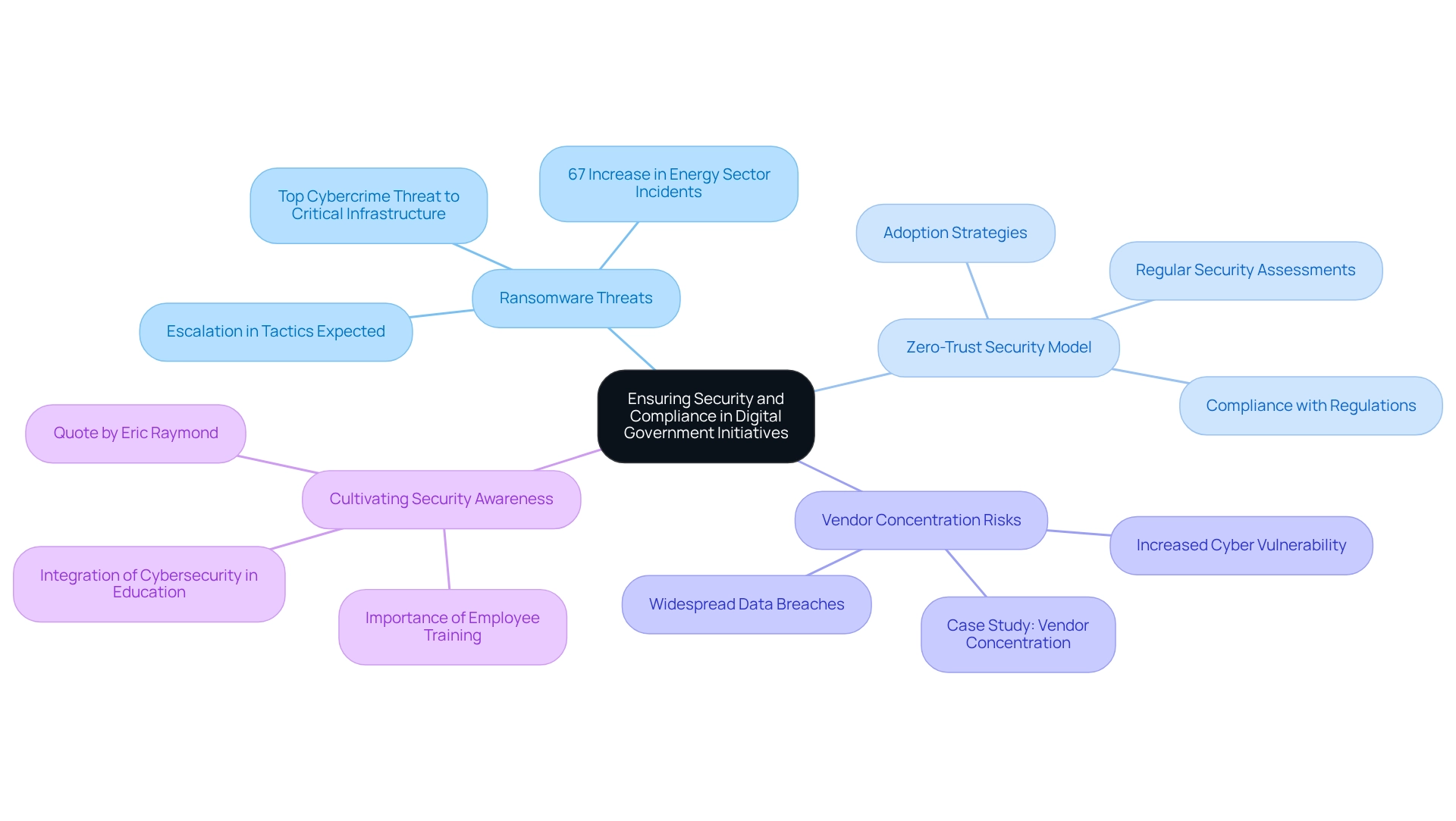
Case Studies: Successful Digital Transformation in Government
Governments globally are increasingly embracing technological transformation, showcasing the benefits of digital transformation in government through numerous successful initiatives that serve as compelling case studies. The Government of Canada has launched its Digital Ambition strategy, aimed at modernizing service delivery and enhancing citizen involvement. This initiative seeks to streamline processes and improve accessibility, ultimately demonstrating the advantages of digital transformation by fostering a more responsive administration.
Furthermore, the UK Government’s Digital Agency has revolutionized public access, underscoring the benefits of digital transformation through significant improvements in user satisfaction and operational efficiency. For instance, the organization has adopted user-focused design principles that prioritize the needs of citizens, resulting in a more intuitive experience when accessing public resources. As noted by customer Gustavo Estrada, “Avatar has simplified complex projects and delivered results within desired time frames and budget constraints,” emphasizing the critical role of effective integration in enhancing service delivery.
In addition, Tony LeBlanc from the Provincial Health Services Authority remarked, “Good team. Good people to work with. Extremely professional. Extremely knowledgeable,” further highlighting Avato’s commitment to excellence.
Avato’s hybrid integration platform is pivotal in these transformative efforts, enabling secure and seamless data connectivity across banking, healthcare, and government sectors. Engineered for 24/7 availability and designed to manage intricate integrations, Avato provides a robust foundation for technological advancement initiatives. This dedication to simplifying disparate systems not only enhances operational efficiency but also drives significant business value creation.
These transformative efforts underscore the critical importance of strategic planning and stakeholder engagement in achieving successful outcomes. However, as organizations navigate the complexities of technological change, they must also address challenges such as cyber threats and skills shortages, recognized as major obstacles by IT decision-makers. A recent study revealed that 24% of IT leaders cite cyber threats as a significant challenge, while 22% highlight the skills gap as a pressing issue.
Avato’s solutions are tailored to mitigate these challenges, ensuring secure transactions and continuous operational uptime. To overcome these obstacles, it is essential for authorities to motivate employees to enhance their skills, ensuring that the workforce is equipped to meet the demands of technological evolution. The potential of technological transformation to drive substantial change in administrative operations is clear, particularly when initiatives are supported by clear objectives and key performance indicators (KPIs). By fostering a culture of continuous improvement and involving employees at every stage, authorities can enhance their service delivery and better meet the evolving needs of their constituents.
As demonstrated in successful case studies, the integration of digital technologies highlights the benefits of digital transformation in government by not only improving efficiency but also strengthening the relationship between citizens and their government.
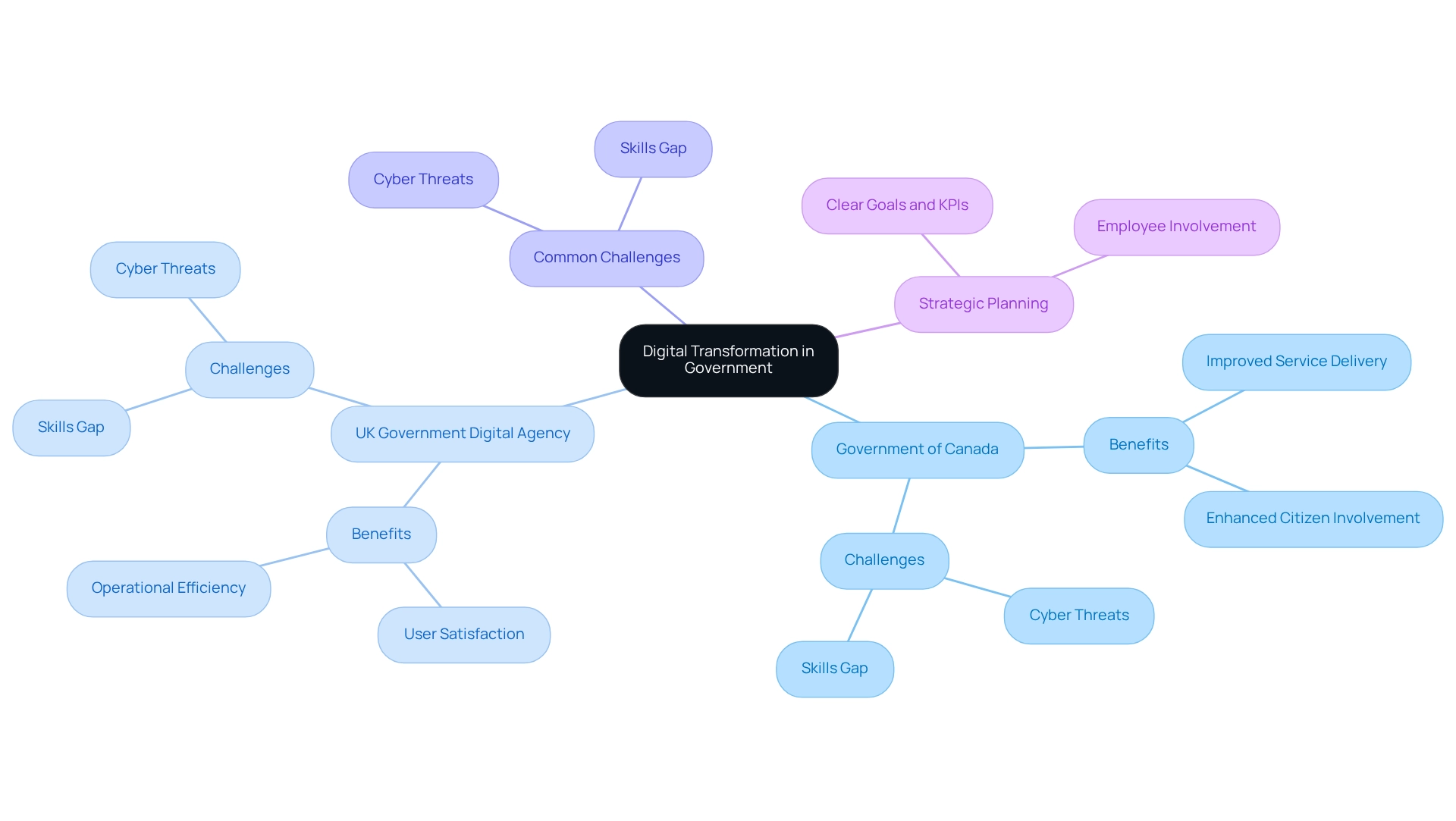
Conclusion
Digital transformation in government signifies a pivotal shift that enhances operational efficiency, citizen engagement, and service delivery. As agencies increasingly adopt digital solutions, they witness substantial improvements, with studies indicating up to a 40% rise in citizen satisfaction. However, the integration of legacy systems poses a significant challenge. Strategic approaches, such as utilizing middleware and APIs, can facilitate modernization and streamline processes.
The importance of effective policy cannot be overstated; it provides the essential framework for fostering innovation and collaboration while ensuring data security. Countries leading in digital governance, such as Estonia and Singapore, exemplify how comprehensive digital strategies can revolutionize public service delivery. Yet, the journey toward successful digital transformation is fraught with obstacles, including resistance to change and the necessity for robust cybersecurity measures.
Ultimately, as governments worldwide prioritize digital initiatives, the focus must remain on leveraging technology to create a more transparent, responsive, and efficient public sector. By addressing the barriers to implementation and fostering a culture of adaptability, agencies can unlock the full potential of digital transformation, enhancing their ability to serve constituents effectively. The journey toward a digitally empowered government is essential for meeting the evolving needs of society and ensuring that public services are equipped for the future.

